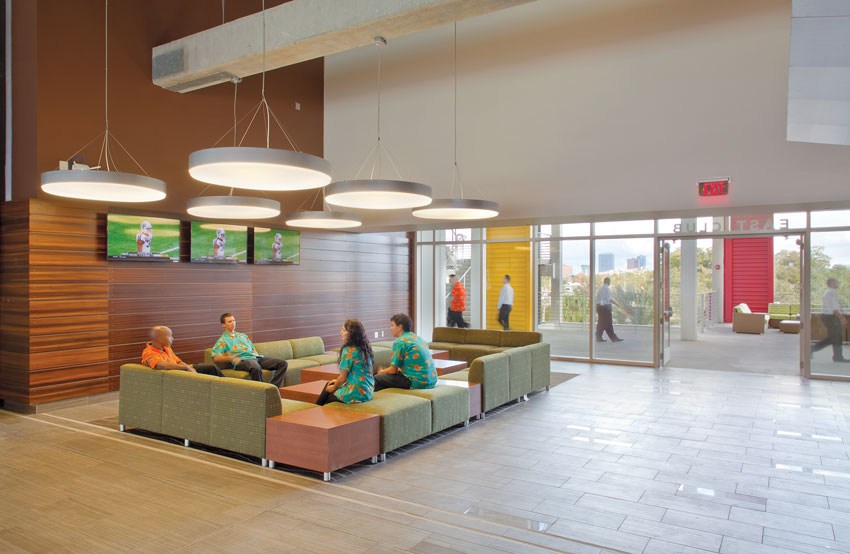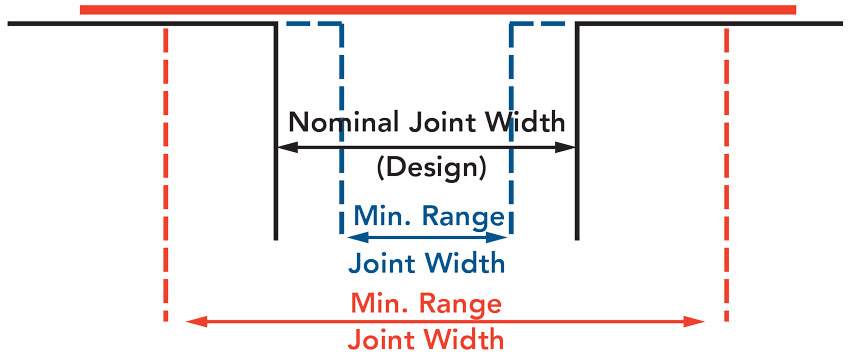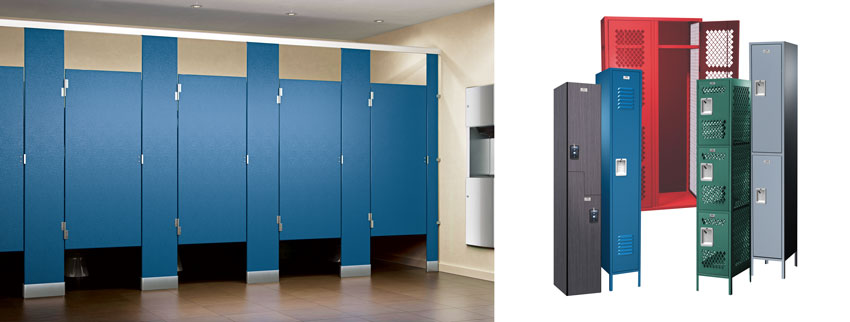System Solutions for Stadiums
Expansion Joint System Durability
With their sheer size and surface area, stadiums are subject to significant movement of floors, walls, and roof areas from thermal or other environmental forces. Expansion joint systems are a necessary component then, but they must be engineered to handle several other factors too. First is the need for high durability of the joint materials and covers to withstand pedestrian traffic, push carts, scissor lifts, etc. Another factor is the ability to act as a moisture barrier since expansion joints in exterior walls or roofs must prevent rainwater infiltration or help channel rainwater to drainage points. Finally, if the expansion joint is in a fire-rated assembly, then the joint needs to be fire rated as well. Since wet fire barriers are worthless, preventing water from entering a fire barrier is critical to life safety. In that regard, choosing a supplier for expansion joint systems and fire barriers that are truly effective cannot be overstressed. Stadium projects often involve large concrete pours over long concourses with multiple expansion joints being typical. The ability of the supplier’s representative to provide alternatives and approved adjustments when the pour “doesn’t go quite right” can be critical to achieving fire ratings, not to mention keeping the construction on schedule.
When looking at expansion joint system selection and specification for stadiums and arenas, the following should be considered.
- Nominal joint size: The designed width of an expansion joint at a median temperature is usually determined by a structural engineer and referred to as the nominal joint width. The selection of all expansion joint systems, whether caulking, cover, or concealing systems, starts with understanding the nominal joint size and the range of movement between the minimum fully contracted size and the maximum fully expanded size. The expansion joint system selected needs to accommodate this full movement range.
- Type of movement: Building sections can move due to several common reasons. Thermal movements are most typical and caused by daily environmental temperature changes in and around the structure. Thermal movement is primarily “one directional” in nature and is the result of the expansion and contraction of structural elements as affected by heat, cold, and humidity levels. The amount of thermal movement is typically approximately 10 to 25 percent of the nominal joint size. Seismic activity can also be a source of movement, which may be horizontal, vertical, in shear, or a combination of all three. Seismic joint widths may need to increase with higher floor levels to protect a structure during earthquakes or other seismic events. These joints must have the capacity for movement of approximately 50 to 100 percent of the nominal width. Finally, wind-load induced movement, caused by high winds, can cause a structure to sway back and forth. Such wind-load induced movement can be perpendicular or parallel to the joint.
- Loading requirements: In this case, loading refers to the type of weight and actions that will be induced onto the joint system, including its cover during building occupancy. This could include pedestrians walking over an expansion joint system or small equipment to heavy-duty vehicles driving over or adjacent to the joints. To optimize the design, consider whether the loads applied will be uniform, irregular, or concentrated under the footprint of wheels.
- Applications and location: The project scope could include interior and exterior joints or both. Typically, the joints need to run continuously through all adjacent planes to fully separate building sections and allow independent movement in things like building veneers, soffits, parking decks, patios, and roofing systems.
- Form and appearance: This item usually depends on the adjacent finishes. There may be different design criteria for back-of-house conditions, public corridors, or high-end spaces. Depending on the aesthetic, there are options for incorporating interior finishes into the joint system, such as applying anodized finishes or coatings, or using foam seal colors to complement the décor, provide an accent, or minimize sightlines.
- Fire-resistance and moisture control: Vapor barriers are generally specified in floor, wall, and roof joints to maintain continuity with adjacent vapor-barrier systems. Sound and thermal barriers are becoming increasingly more important, especially with expansion joint systems in buildings with tight, energy-efficient envelopes. Fire-barrier systems are specified in floor and wall joints in fire-rated locations as dictated by codes. Fire-rated joint systems should be tested to meet ASTM Standard E1966 based on fire exposure and ASTM E1399 which tests the ability of the joint to remain intact and perform to the minimum and maximum extents under cyclic movement.
With the above considerations taken into account, the selection of expansion joint systems can be worked into specifications and construction drawings to help assure the stadium or arena is properly allowed to move, remains weather and moisture tight, and protects life safety.

Large buildings such as stadiums need expansion joints for the integrity of the building. But strength and durability can also be coupled with aesthetics and décor, as shown here at the Citrus Bowl stadium in Orlando, Florida. The joint pan incorporates the floor finish, and coordinated seal colors allow the joint to blend right in, which reduces sightline disruption.

Images courtesy of Inpro
Durable expansion joint systems in stadiums and arenas need to be sized properly to allow for the nominal, minimum, and maximum openings due to thermal expansion and contraction.
Restroom and Locker Room Design
Restrooms in a stadium/arena play an increasingly important role in the individual user experience. What may have worked well 20 or 30 years ago may not work today so it is important to view design, as well as product and material choices, with a fresh perspective.
A well-designed restroom can accentuate great memories of a visit by providing a trouble-free or even positive user experience. However, as documented in a variety of instances, a bad restroom experience, particularly on opening day, can prove disastrous for the reputation of the stadium, its owners, and also the design team.
This disproportionate impact restrooms have in the overall user experience of any building comes about for a variety of reasons, but in stadiums, three specific ones stand out: 1) stadium restrooms have a higher frequency of use in a short amount of time compared to most other buildings; 2) using a bathroom by definition is a very personal experience and, in stadiums or arenas, privacy is often hard to achieve; 3) stadium bathrooms must meet a variety of programmatic needs, the needs of a very wide cross section of people, and some fundamental needs, such as safety, hygiene, and speed of use. Satisfying those needs can be achieved as long as the design details are given their requisite attention.
The first response of a design team to meet the needs of stadium restroom users is to locate an appropriate number of restrooms within close physical intervals to accommodate crowds. Within each of the restrooms, there should be an appropriate number of toilet and hand wash stations, and there must be the proper amount of consumables, such as soap, paper hand towels, and toilet tissue rolls, to avoid users being inconvenienced. Of course, there are other variables to address too, based on differences between individual stadiums, their geographic locations, and the varied cross section of visitors.
Cyrus Boatwalla, head of marketing with ASI Group, has noted, “Restrooms in a stadium are typically used in short bursts with a high volume of users. Whether during a seventh-inning stretch, half-time of a basketball game, television timeout in football, or between sets at a music concert, the facility better be ready for an onslaught of people who want to use the restroom quickly and get back to their seat/spot as fast as they can so they don’t miss any of the action.” It is easy to see that restroom maintenance between these short bursts plays a big factor in the user experience. But the design capacity and path of travel to, from, and within the restrooms are significant too. Therefore, factors that can negatively impact the user experience can be mitigated by some well-thought-out designs and layout.
When designing stadium restrooms, it is important to recognize the variety of design criteria that are important to end users (customers), building owners, code officials, and facility maintenance staff. The design team must take the factors below, among others, into account.
- Mitigating safety risks from hazards, such as wet floors. Wet floors are often a function of the location and number of drying stations in respect to sinks since water will drip from wet hands on the way to get them dry. Compounding this issue, some automatic hand dryers push water to the floor or have areas in the dryer where water can collect. Without a proper moisture management or drainage system, that water will overflow onto the floor or be a breeding ground for bacteria if it stays stagnant.
- Allowing for a higher frequency of use than in other buildings during a shorter occupancy time because of how much people drink or eat during their visit.
- Creating efficiently designed restrooms to limit lines, thus allowing customers to quickly use and exit a bathroom so they don’t miss what they came to the stadium for in the first place—the game, a concert, or a professional conference.
- Allowing for accessibility (ADA) compliance with the appropriate number of accessible stalls and stations. Making restrooms accessible in all respects ensures that everyone can have an equally pleasant stadium experience.
- Allowing for diversity. Understand that some stadiums may require restrooms that need to cater to the special needs of people from different cultures or walks of life. If stadium owners or municipal leaders want to ensure an inclusive experience, they must pay attention to the diversity of needs as well.
- Accommodating people with children of all ages, including those who need to have their diaper changed. This allows stadiums to be family friendly, particularly when enough changing stations are provided in both the men’s and women’s restrooms.
- Installing ultimate-privacy stalls in an adequate number with zero sight lines into the stall. Achieving this involves panels and doors that are lower to the floor and higher to the ceiling than typical stalls, thus providing a safe and stress-free environment for those who desire even greater privacy.
- Allowing for different restroom types. Even within the same stadium, there may be many different needs depending on user segmentation. Luxury suites with private restrooms might require unique fixtures, or large public restrooms prone to damage may need thicker-gauge materials. Employee restrooms and team facilities may need different types of lockers, showers, and changing areas.
Beyond design and layout, making good product and material choices also plays directly into the overall user experience of restrooms and locker rooms. This includes toilet partitions, lockers, washroom accessories, and plumbing fixtures. In that regard, it is important to work with manufacturers that can provide a variety of choices for the different restroom needs of a stadium. Some common discussions that go on between architects and manufacturers address ways to optimize restroom design and user experiences in stadiums and arenas. These can include things like the types of materials to use in toilet partitions, with phenolic and solid plastic often being preferred for design versatility, durability, and ease of maintenance. The conversations can also center around ways to keep floors in the restroom dry without water dripping on the floor. High-speed electric hand dryers that have moisture management systems can be a good solution for this situation while reducing paper towel waste. However, paper towels should not be overlooked because some people prefer them over dryers, and if paper towel dispensers are used, then ideally at least one dispenser should be located near each sink for fast, efficient usage.
Overall, stadium restrooms do not follow a one-size-fits-all approach. Rather, architects and designers need to assess the various needs within a stadium facility and then work with manufacturers that can provide the wide range of options to be selected from to suit those needs.

Images courtesy of ASI Group
Restroom and locker room design in stadiums must address a wide variety of needs and criteria. Working with manufacturers who can provide the necessary accessories and products to meet those needs is a good design strategy.
Notice

www.americanspecialties.com


www.nanawall.com









